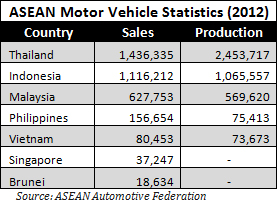ASEAN Automobile Market to See Continued Growth
Aug. 16 – A recent report released by market research and consulting firm Frost & Sullivan notes that the Association of Southeast Asian Nations (ASEAN) is expected to become the fifth largest buyer of cars by 2019. Fueled by rising incomes and a prime-age demographic, ASEAN’s automobile market has been forecasted to grow at a compound annual rate of 5.8 percent through 2019, “[poising ASEAN] to become a global automotive production hub.”
At the forefront of the ASEAN automotive boom is Indonesia and Thailand, who both have had the total number of cars on their roads surpass the 1 million mark already this year – the most of any ASEAN nation.
Vijay Rao, research director at Frost & Sullivan, added that “Indonesia is expected to emerge as the largest automotive market in ASEAN by 2019, accounting for 2.3 million vehicles, driven by sustained economic growth in the country, growing middle classes with larger disposable incomes, increased investments in automotive sector and the introduction of automotive regulations supporting market growth.”
Furthermore, the Malaysian automobile market has also already seen increased growth this year, with the number of vehicles in the country topping 600,000. Specifically, hybrid vehicles saw the greatest growth in Malaysia thanks to incentives offered by the government.
For comparison, in 2010, there were just over 300 hybrids in Malaysia. By 2012, that number had reached 15,355 – an increase of 5,000 percent.

Frost & Sullivan also expects to see growth in ASEAN automobile production, forecasting a compound annual growth rate of 8 percent through 2019, with the capacity to produce 7 million units by that time.
“Thailand is likely to continue its dominance as a major production hub in ASEAN due to expected significant capacity expansions, increased export and domestic demand, [and the] availability of a skilled labor force with a well-developed automotive component industry,” affirmed Mr Rao.
Malaysia has also seen recent growth in its automotive industry, with multiple European and Chinese companies looking to establish original equipment manufacturing facilities throughout the country.
You can stay up to date with the latest business and investment trends across Asia by subscribing to Asia Briefing’s complimentary update service featuring news, commentary, guides, and multimedia resources.
- Previous Article Myanmar Approves Plans for New International Airport
- Next Article Laos Expands Rail Projects








